Fire lance
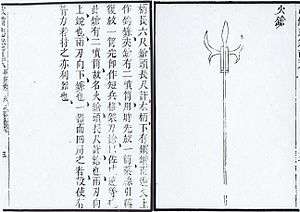
The fire lance (simplified Chinese: 火枪; traditional Chinese: 火槍; pinyin: huǒ qiāng) was a gunpowder weapon that appeared in 10th century China during the Jin-Song Wars. It is considered to be a proto-gun, the predecessor of the hand cannon, and the ancestor of all firearms.[1]
Description
Fire lances were relatively short range weapons and were used to give their user an advantage in close quarters combat.[2]
The first fire lances consisted of a tube, usually bamboo, containing gunpowder and a slow match, strapped to a spear or other polearm weapon. Once ignited, the gunpowder tube would ideally eject a stream of flames in the direction of the spearhead. Co-viative projectiles such as iron pellets or pottery shards were later added to the gunpowder. Upon firing, the gunpowder charge ejected the projectiles along with the flame.[3]
Metal fire lance barrels appeared around the mid 13th century and these began to be used independently of the lance itself. The independent metal barrel was known as an 'eruptor' and became the forerunner of the hand cannon.[3]
History
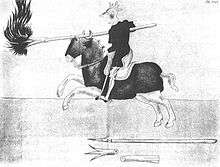
The first evidence of fire-lances appeared in China in the year 950 and fire lances were also mentioned in the military text Wujing Zongyao of 1044. However usage of fire lances in warfare was not mentioned until 1132 when Song garrisons used them during the Siege of De'an, in modern day Anlu, Hubei, when fire lance troops led the vanguard in a sortie against the Jin dynasty (1115–1234).
In 1163 fire lances were attached to war carts known as "at-your-desire-carts" used to defend mobile firembomb trebuchets.
In the late 1100s pieces of shrapnel such as porcelain shards and small iron pellets were added to the gunpowder tube. At some point fire lances discarded the spearhead altogether and relied solely on their firepower.[4]
By 1232 the Jin were also using fire lances, but with improved reusable barrels consisting of durable paper material. According to the History of Jin, these fire lances had a range of roughly three meters:
To make the lance, use chi-huang paper, sixteen layers of it for the tube, and make it a bit longer than two feet. Stuff it with willow charcoal, iron fragments, magnet ends, sulfur, white arsenic [probably an error that should mean saltpeter], and other ingredients, and put a fuse to the end. Each troop has hanging on him a little iron pot to keep fire [probably hot coals], and when it's time to do battle, the flames shoot out the front of the lance more than ten feet, and when the gunpowder is depleted, the tube isn't destroyed.[5]
The Mongol soldiers which they were used against were apparently disdainful of other Jin weapons, but greatly feared the fire lance. Jin soldiers also used them in open combat and in one instance, a contingent of 450 fire lancers routed an entire Mongol encampment.[6]
In 1259 a pellet wad that occluded the barrel was recorded to have been used as a fire lance projectile, making it the first recorded bullet in history.[4]
By 1276 fire lances had transitioned to metal barrels.[7]
The metal-barreled fire lance began to be used independently of the lance around the mid to late 13th century. These proto-cannons which fired co-viative projectiles, known as 'eruptors,' were the forerunners of the hand cannon.[4]
By 1280 the Middle East had acquired fire lances.[8]
In 1396 European knights took up fire lances as mounted weapons.[9]
The last recorded usage of fire lances in Europe occurred during the Storming of Bristol in 1643.[10]
Gallery

 A fire lance as depicted in the Huolongjing.
A fire lance as depicted in the Huolongjing.- The phalanx-charging fire-gourd, one of many fire lance types discharging lead pellets in the gunpowder blast, an illustration from the Huolongjing.
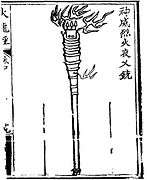 An 'awe-inspiring fierce-fire yaksha gun' as depicted in the Huolongjing.
An 'awe-inspiring fierce-fire yaksha gun' as depicted in the Huolongjing.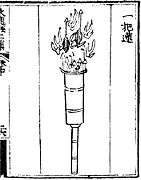 A 'lotus bunch' as depicted in the Huolongjing. It is a bamboo tube firing darts along with flames.
A 'lotus bunch' as depicted in the Huolongjing. It is a bamboo tube firing darts along with flames.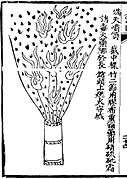 A 'sky-filling spurting-tube' as depicted in the Huolongjing. A bamboo tube filled with a mixture of gunpowder and porcelain fragments.
A 'sky-filling spurting-tube' as depicted in the Huolongjing. A bamboo tube filled with a mixture of gunpowder and porcelain fragments. A 'bandit-striking penetrating gun' as depicted in the Huolongjing. The first known metal barreled fire lance, it throws low nitrate gunpowder flames along with coviative missiles.
A 'bandit-striking penetrating gun' as depicted in the Huolongjing. The first known metal barreled fire lance, it throws low nitrate gunpowder flames along with coviative missiles.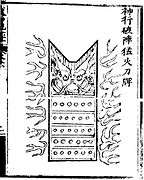 A 'divine moving phalanx-breaking fierce-fire sword-shield' as depicted in the Huolongjing. A mobile shield fitted with fire lances used to break enemy formations.
A 'divine moving phalanx-breaking fierce-fire sword-shield' as depicted in the Huolongjing. A mobile shield fitted with fire lances used to break enemy formations.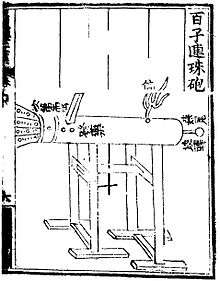 Essentially a fire lance on a frame, the 'multiple bullets magazine eruptor' shoots lead shots, which are loaded in a magazine and fed into the barrel when turned around on its axis.
Essentially a fire lance on a frame, the 'multiple bullets magazine eruptor' shoots lead shots, which are loaded in a magazine and fed into the barrel when turned around on its axis.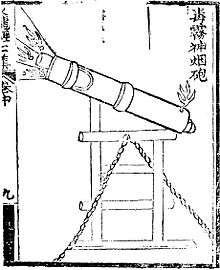 A 'poison fog magic smoke eruptor' as depicted in the Huolongjing. Small shells emitting poisonous smoke are fired.
A 'poison fog magic smoke eruptor' as depicted in the Huolongjing. Small shells emitting poisonous smoke are fired.- The 'flying-cloud thunderclap-eruptor' cannon from the Huolongjing.
 Illustrations of fire lances from De la pirotechnia by Vannoccio Biringuccio ca. 1540.
Illustrations of fire lances from De la pirotechnia by Vannoccio Biringuccio ca. 1540.
See also
Citations
- ↑ Andrade 2016, p. 33.
- ↑ Andrade 2016, p. 38.
- 1 2 Andrade 2016, p. 51.
- 1 2 3 Andrade 2016, p. 52.
- ↑ Andrade 2016, p. 46.
- ↑ Andrade 2016, p. 47.
- ↑ Needham 1986, p. 228.
- ↑ Needham 1986, p. 259.
- ↑ Needham 1986, p. 260.
- ↑ Needham 1986, p. 262.
- ↑ "The Genius of China", Robert Temple
References
- Andrade, Tonio (2016), The Gunpowder Age: China, Military Innovation, and the Rise of the West in World History, Princeton University Press, ISBN 978-0-691-13597-7.
- Needham, Joseph (1986), Science & Civilisation in China, V:7: The Gunpowder Epic, Cambridge University Press, ISBN 0-521-30358-3.
External links
- Little Bit of Info on the Fire Lance
- Medieval Chinese Armies, 1260-1520 (Men-at-arms S.) by Chris J. Peers. ISBN 1-85532-599-3
- Chinese Siege Warfare: Mechanical Artillery & Siege Weapons of Antiquity